1935 Sewer Gator Story Confirmed
Posted by: Loren Coleman on November 24th, 2009
The New York Times rather casually and without fanfare has confirmed a significant event in alligator-in-the-sewers history. The actual teenager who had the confrontation with the over seven-foot-long sewer alligator in 1935 was tracked down, interviewed last week, and verifies it wasn’t just an elaborate newspaper tale.
As you will recall…noted in A. G. Sulzberger’s breaking New York Times article…in an era when several news items told of out-of-place gators being found…
The most widely cited of these was an article in The Times on Feb. 10, 1935, headlined “Alligator Found in Uptown Sewer.”
That article described several people — led by a teenager named Salvatore Condoluci — who had caught and ultimately killed a seven- to eight-foot-long alligator they discovered beneath an open manhole on 123rd Street near the Harlem River.
The occasion of this reexamination of these stories is the 50th anniversary of the publication of Robert Daley’s 1959 The World Beneath the City. The reporter interviewed Daley and others last week for this new article. I was one of those people he interviewed, for his background work on his piece.
I conducted a great deal of research on this topic in the beginning years of the 1970s. (Of course, it continues today, as well.) I made a unique discovery that alligators-in-the-sewers were not all just legendary, not from the 1960s as folklorists thought, but had a firm newspaper history three decades earlier.
I tracked down articles that noted real alligators were found and killed in New York City, specifically in that city’s sewers in the 1930s. My formal published contribution on this appeared as “Alligators-in-the-Sewers: A Journalistic Vehicle,” in the Journal of American Folklore, September-October 1979. No one had before then, found, linked it to the “urban legend,” and re-published anew the The New York Times, February 10, 1935, article.
I put a chapter in my book, Mysterious America, and kept updating it (1983, 2001, 2007), about these specific gators. The reports also are heard from elsewhere too.
Here’s how the New York Times puts it:
“These tales had a journalistic background,” said Loren Coleman, director and curator of the International Cryptozoology Museum in Portland, Me., who has researched and written about the topic for decades. “Daley’s book came along, and it was almost like independent confirmation.”
A. G. Sulzberger interviewed Daly last week, and then wrote:
When discussing the book with James A. Lundy, a former Queens borough president, Mr. Daley said he was told to speak with Edward P. May, known as Teddy. “Ask him about the alligators,” Mr. Lundy commanded.
So Mr. Daley sat on a stoop with Mr. May, who described his story of disbelief and discovery and detailed his efforts to rid the sewers of the alligators: poisoning some, chasing others into the fast-moving main tunnels where they were swept out to sea, and permitting his inspectors to hunt down the rest with rifles and pistols for sport.

The New York Times Studio
Robert Daley in 1960, when he was a reporter for The Times.
“He started telling me about the alligators in the sewer,” Mr. Daley remembered. “He wasn’t joking. He told me a lot of good stuff, and I accepted it as the truth.”
“He convinced me it was a true story without even trying,” he added. “He wasn’t trying to win me over or convince me — the stuff just kept coming out.”
He said he still believed that Mr. May was telling the truth, even if the numbers could have been exaggerated. “And besides,” Mr. Daley added, “it made a terrific story. How could you turn that down?”
The tale spread rapidly.
When Mr. May died in 1960, after the publication of the book, his obituary in The Times said, “Once Mr. May led a squad in cleaning the sewers of a number of live alligators that, discarded in the sewers as tiny pets, and survived and grown large.”
Sulzberger’s crowning achievement in the background work he put into this new take on the alligator events, however, was his tracking down of the actual teenager who had the 1935 experience. A. G. Sulzberger penned these words in his concluding remarks:
Salvatore Condoluci, the teenager who roped that alligator, is now 92.
Though he has forgotten some of the details, he still remembers hearing the thrashing in the icy water beneath the manhole, first seeing the creature’s head, and using a rope to lasso and haul it to the surface.
But Mr. Condoluci isn’t sure whether he believes that other alligators lurk below. “I don’t know,” he said. “I really don’t know.”
The historical record regarding the actual hunts conducted in the 1930s, by rifle-toting city sewer workers who located and shot the gators, along with the eyewitness accounts by Salvatore Condoluci and others, have been confirmed anew. This is a fact, despite the continuing modern denials of the acting director of the City of New York Department of Environmental Protection, I must note.
A whimsical bronze sculpture by Tom Otterness in the 14th Street subway station on the A, C, E and L lines makes reference to the old legend of alligators in the sewers. Tyler Hicks/The New York Times
For the entire article “The Book Behind the Sewer-Alligator Legend” by A. G. Sulzberger, click here.
For a comprehensive look at the entire topic, with updates, see Mysterious America from Simon and Schuster, 2007.
+++++++++
Autographed copies of Loren Coleman’s books are available at the following location:
The International Cryptozoology Museum will be open from 9:30 am to 6 pm on Friday, November 27, 2009. It will have normal hours on Saturday, 11 am to 6 pm, and Sunday, Noon to 5 pm, and will be closed on Monday. I will have extended hours on the Saturday before Christmas, December 19th, also.
Also, for one month only, the following Holiday Specials are available. These can be purchased in person at the museum, via email or snail mail. These too are in response to individuals who wanted “gift certificates” to place in stockings and to give as gifts to friends and family. Individual gift certificates for one to several visits are now available in person, via email and through snail mail to allow the bearer (whomever holds the certificate of admission) into the museum. These will have NO expiration dates, and thus can serve as a “future promise” of a trip to Portland, Maine, when you give them as gifts.
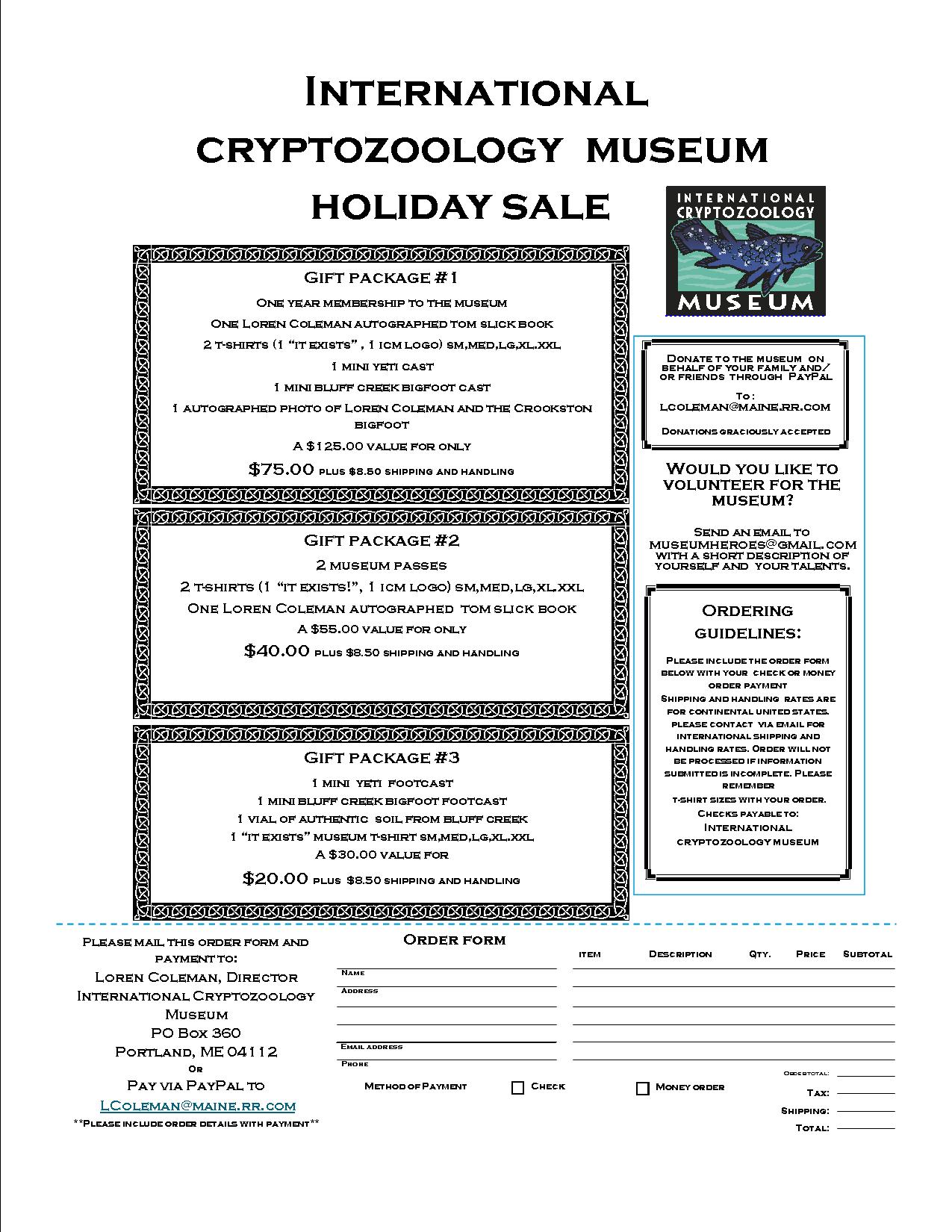
Click on the “Holiday Flyer” above to increase in size and then click again to make even more readable.
The donation button below may be used as a clickable direct link to PayPal (even if you are not a PayPal member) to send funds for your gift certificates and museum holiday purchases, as well as welcome contributions to the museum. Followup with an email to LColeman@maine.rr.com for order specifics, if you do not see a comment box.
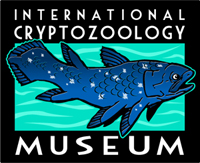
Thank you!
About Loren Coleman
Loren Coleman is one of the world’s leading cryptozoologists, some say “the” leading living cryptozoologist. Certainly, he is acknowledged as the current living American researcher and writer who has most popularized cryptozoology in the late 20th and early 21st centuries.
Starting his fieldwork and investigations in 1960, after traveling and trekking extensively in pursuit of cryptozoological mysteries, Coleman began writing to share his experiences in 1969. An honorary member of Ivan T. Sanderson’s Society for the Investigation of the Unexplained in the 1970s, Coleman has been bestowed with similar honorary memberships of the North Idaho College Cryptozoology Club in 1983, and in subsequent years, that of the British Columbia Scientific Cryptozoology Club, CryptoSafari International, and other international organizations. He was also a Life Member and Benefactor of the International Society of Cryptozoology (now-defunct).
Loren Coleman’s daily blog, as a member of the Cryptomundo Team, served as an ongoing avenue of communication for the ever-growing body of cryptozoo news from 2005 through 2013. He returned as an infrequent contributor beginning Halloween week of 2015.
Coleman is the founder in 2003, and current director of the International Cryptozoology Museum in Portland, Maine.

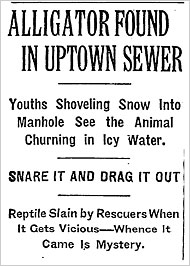
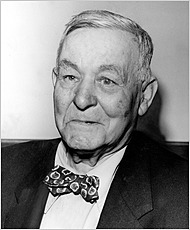
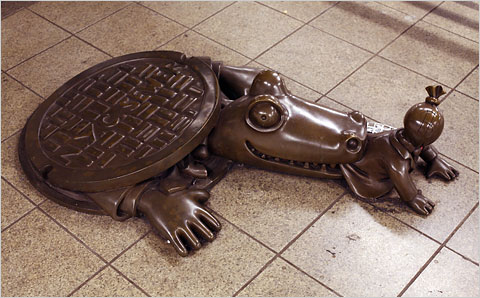
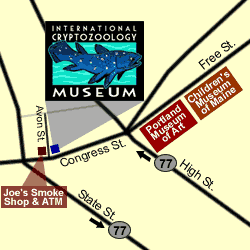









Alligators in the sewers? Why not?
In that era it was not uncommon to bring baby gators home from Florida as a pet. This practice went on into the early 1960’s. I remember a family member of mine brought a hatchling home in a suitcase. He thought it was great fun and a lark to have the animal in his room. Eventually, it was donated to a small zoo. It’s not a stretch to imagine some being left free in the sewers of New York. In a time before serious conservation many people didn’t think about the impact on the species.
What intrigues me most about this article is the bronze sculpture. That gator has on a suit and is complete with man’s hands. A copy of that bronze needs to be placed in every state and federal government building. No better representation of the private sector/ public sector relationship has been ever conceived.
I’m glad there is “verification” that this “occurrence” is NOT TOTALLY an Urban Legend. If it happned THEN, who’s to say it is not happening NOW? I myself have no doubt but I do understand there are “scientific procedures” one has to consider first. Mystery_Man was open to this. 🙂
Cryptidsrus- Indeed I have always been open to the idea of alligators in the sewers, and I remember there was a very good, constructive discussion on the possibilities of this awhile back here on Cryptomundo which I was involved in.
There really aren’t too many reasons why we could not expect alligators to survive at least for the short term in these conditions, yet many reasons why they could.
For instance, there are lots of animals to eat such as rats, possums, raccoons, and others. Alligators don’t just eat big things like deer and other large prey. They can and will eat pretty much anything they can get their teeth on, and in the wild will eat birds, turtles, small reptiles, you name it. They will also eat decomposing carcasses if the chance presents itself. With such an opportunistic and generalized diet, the sewer could provide plenty to eat for an animal like the alligator.
Temperatures are also not as much of a problem as people tend to think, even in a place that would typically be considered far too cold to support cold blooded animals such as alligators. The reason for this is that decomposing refuse actually produces a good amount of heat in an enclosed environment such as a sewer. Even in the cold winter months, there would be areas in the sewer that would be positively balmy.
The concerns of infection from the filthy, cesspool conditions are somewhat misplaced as well, due to the incredibly effective immune system that alligators have. Many do not realize just how resistant alligators are to infection. Alligator immune systems are potent, able to take out a vast range of bacteria, viruses, and other dangerous microbes, as well as fungi and other infectious agents. They can even fight off microbes that they have never been previously exposed to. Just a few of the infectious agents that alligator blood has been found to effectively combat are HIV, E. coli, strep, and staph, including the highly methicillin resistant Straphylococcus aureus strain, among many others. Researchers have been increasingly astounded by the infection fighting capabilities inherit in alligators. It’s no wonder that medical researchers are busy trying to figure out the alligator immune system for possible future applications in human patients.
On top of their strong resilience in the face of infection, alligators also display a fast healing rate. These features come in handy in the bacteria infested swamps that alligators inhabit, where they engage in fierce territorial battles. I have no doubt that this contributed greatly to the evolution of these traits. Simply put, the gators that could survive these ferocious battles and subsequently both heal quickly and stave off infections, would be the ones most likely to pass this on to future generations.
So we have food, warmth, and a high resistance to infection, three key things that are stacked in an alligator’s favor when finding itself in the sewers.
There are just a couple of problems I’ve always thought would be hard for an alligator to surmount in order to survive in this environment for any appreciable length of time. These are sunlight and man made chemicals.
Alligators are going to need sunlight in order to make sure they have adequate levels of nutrients derived from it. Now this could come from hanging out near gratings where the sun comes through, but it has been pointed out by the poster Cliff (an engineer with quite some knowledge of sewer systems) that it is no easy task for anything of this size to go back and forth from the upper sewer levels where the sunlight would be, to the lower levels where the warmth would be. I had the impression it was not really possible. I’ve always wondered just how alligators could get around the challenge of the lack of sunlight in the sewers.
The second problem is man made chemicals. Tons of junk gets flushed and dumped into the sewers every day, and the concentration of dangerous chemical compounds down there must surely be high. While alligators show remarkable resistance to microbes and fungi, this is not necessarily true for the toxic chemicals that can be found in detergents, plastics, pesticides, fertilizers, and others. These agents could very possibly disrupt the alligators’ hormone balances and other body processes, which would in turn lead to issues such as the retardation of growth, altered behavior, the disruption of reproductive systems, and other detrimental health conditions.
But these concerns cannot dispute the fact that quite obviously some alligators were indeed down there in the sewers. I’d be interested to see just how long these specific gators mentioned here had been coping in that habitat. I tend to find it quite plausible that gators could survive in the sewers at least temporarily, but I am somewhat curious as to whether they could do so for a long period of time, and if they would at all be capable of a breeding population under these conditions.
But I am indeed open to any possibilities. 🙂 Anyway, interesting stuff!
Contained in Mystery Man’s long comment above is the usual red herring about “sunlight.”
Although this was addressed in the MonsterQuest episode on gators in the sewers, several people seem to have missed this or have not been able to view it.
People would be aghast to learn how alligators are raised on alligator farms, but the reality is they are grown in almost total darkness (in many ways not unlike the circumstances to be found in the hot, humid, dark sewers of an urban area).
Here’s what one academic paper observed about the normal conditions on an alligator farm:
“Alligators were kept at a constant ambient temperature of 32 C in water-filled igloo-shaped or rectangular concrete pens, which on average held approximately 200 animals of approximately the same size and age. The igloo-shaped pens had 848–897 l of water and the rectangular pens had 799–3,464 l of water. Pens were kept dark and completely enclosed with the exception of narrow gaps around the entry door for feeding or maintenance. Pens were provided with chlorine-treated well water that was drained and refilled three times a week. Alligators were maintained on a diet of ground beef and alligator chow.”
(Source: Journal of Wildlife Diseases, 41(1), 2005, pp. 96-106)
Alligator farmers learned long ago that alligators grow faster and are healthier if grown for their meat in darkened pens.
Consider this, alligators outlived the dinosaurs by being extremely flexible in a variety of living conditions. Sewers, filled with plentiful food, such as rats, plus rather warm temperatures in watery settings, do not sound too wonderful by human standards, but for alligators, it’s rather close to gator heaven.
Also, as has been pointed out by various comment-makers at the Boing Boing discussion about his topic, the human diet contains extra amounts of Vitamin D in our foods and the toxic flushings that end up in the sewers. Due to the fact that humans don’t get as much sunshine as we need, the boost to our diets do have a spillover (pun intended) to any animals living in urban sewers, which could then, in turn, be eaten by alligators.
Thank you Loren. That was what I wanted to know and what I was hoping for when I posed my concerns on the potential challenges facing gators in a sewer. Of course as I said, with food, warmth, and the alligator immune system, sewers would in many ways be perfectly acceptable environments for alligators. Those are certainly interesting points regarding the vitamin D problem I mentioned.
Thank you for going over that here, as I am sure there are others who wonder about the very same thing.
Oh and sorry about the length of my post. You know me. 😉
I always laugh when I see this topic. I found the article in a 1935 Indianapolis paper in 1992 when I was doing research for a totally unrelated magazine article and sent the info to the Folklore Dept. at Indiana University. (I have a minor in Folklore). I thought I had really made history! I never heard back from IU and later when I got Loren’s book I saw he had found the article more than a decade before me! LOL